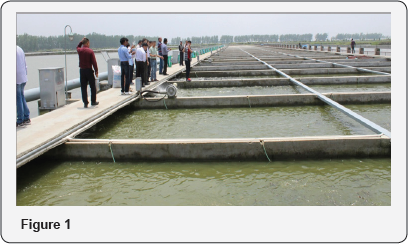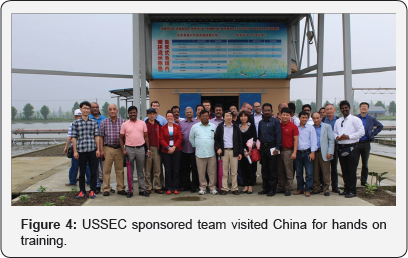Precision Aquaculture: IPAT- Juniper Publishers
Juniper Publishers- Journal of Oceanography
Introduction

The Definitive Principles of aquaculture cannot be written in indelible ink. This science is a part of a continuously improvement program. Way back in 1960’s it was recommended to feed the carps with rice bran and oil cake, because they were available in cheap. After the realization that these organic feeds are poorly utilized by fish and the fact that nowadays these raw materials for many other beneficial and much more economical activities and with increased demand, the cost of these raw materials has increased significantly. As advised in classic aquaculture, if it is mixed in 1:1 ratio and fed to fish, the cost of production will be Rs. 99/kg. But now in many parts of the country, the farm gate value of carps (Rs. 80/kg) does not rise above the cost of production. Till recently, carp seed rearing and farming at any scale was highly profitable because of the low cost for the inputs. But this is no longer true, as the cost of basic traditional inputs like cow dung, poultry manure, ground nut cake, rice bran and fixed costs of land; total input costs have increased many fold, while the farm gate value of the fish seed and market size fish remained almost constant. Though aquaculture production models are highly dynamic, unless we assess the economics and understand the scale of economy of any given activity, systems may not be economically or environmentally sustainable. In early sixties, most of the aquaculture production systems were extensive- that is using a low input extensive approach to production. Rice bran, ground nut cake (GNC) and cow dung was available then at cheaper cost. The cost of GNC in 1983 was Rs. 3.80 and it is Rs. 40/kg in 2014. The cost of rice bran was Rs. 1.60 and it is Rs. 18-20/kg currently (Figure 1).
USSEC Sponsored IPAT Program in India
US Soy Bean Export Council invited different stakeholders related to aquaculture and organized two programs in India. One at Vishakapattanam on 17.05.2016 and another at Kolkata on 20.05.2016. Mr Umakanth and Dr Yadunandan, and the USSEC team were instrumental in bringing different stakeholders on one platform to discuss a new aquaculture technology. Mr George Fullerton, Auburn University, USA delivered a special talk describing Intensive Pond Aquaculture Technology or IPAT. It was simplified and technically narrated by Dr Vijay Anand, Director, Asia Sub Continent, for USSEC. The institutes like National Fisheries Development Board, Hyderabad, Central Marine Fisheries Research Institute, Cochin, Central Institute of Brackishwater Aquaculture, Chennai, College of Fisheries, Mangaluru, Aquafeed producers, progressive farmers, shrimp hatchery owners and others related to field of aquaculture were present. The concept was well received by the stakeholders.
Visit to China
In continuation with the above described program in India, the selected group of stakeholders was taken to China to visit farms which demonstrate show the successful IPAT models. See and learn is better than hear and learn. The team of 60 delegates from countries like India, Vietnam, Egypt, China and USA were there as participants. Dr Jesse A. Chappell, Extension Specialist, Auburn University, Ms Deena Hansel, Aquaculture Program Manager, USSEC, Xiaoping Zhang, China Country Director, Mr Joe Zhou Enhua, Technical Manager-freshwater Aquaculture, USSEC, China, Dr Lee, USSEC, China, Mr. Jim Zhang, Program Manager- Aquaculture, USSEC, China, were moderating and technically facilitated the Program.
Delegates were taken to a Government of Farm which is 70km away from Shanghai City. Dr Chappell explained the concepts and immediately delegates were taken to the IPAT farm just few meters away from their office. Then everybody was able to actually see and learn from a real-world operating IPA system I had many doubts when I was listening to IPAT lecture at Vizag, India. Had I asked those questions, it would have been rude on my part for asking such questions. Thank god, I got a chance to see what they were telling in their lectures.
What is this IPAT?

Integrated Pond Aquaculture Technology (IPAT) developed by Auburn University and USSEC is trying to popularize this technology globally. It is just developing raceway structures within the pond system and creating river-flow within the system using only air! Remember those who are getting good fish or shrimp production with Mekong River using its robust natural flow. In an earthen pond say about 1ha, the production raceway or cells having 6-9 inch thick walls and measuring 25m X 5m X 1.5m. The total area of the cells will not cross 0.01.5% of the total area of the earthen pond. This means a 150m2 cell area is enough for 1ha pond. Using air blowers at the inlet end, water is airlifted and taken through the raceway and subsequently to the pond. The last addition 3m length of the cell is a solids or sludge collection point. Sludge is collected using simple pumps which move along the width of the cell. In 150 days, the grass carp production ranges from 140-160kg/m3. In China, they were culturing grass carp, channel catfish, big head carp, etc. They were fed to satiation with soy based floating feeds using automatic feeders. The production cells are positioned at one corner of the ponds. The water gushes out from the cells is guided by a baffle till the opposite corner later by using aerators, water is guided and makes a circular motion and ultimately again reaches the inlet of the cells. The technology is based upon continually flowing water pushed around the pond by air-lifts (Figure 2).
Is it Really Version 8.0?
Indian aquaculture started with stocking wild seeds (version1.0) later moved to stocking hatchery bred seed (Version2.0) along with a manuring schedule (Version 3.0) which wasnatural food based. Slowly, farmers started feeding rice bran and ground nut cake (Version 4.0). With continued advancement in aquaculture technology growers began using aerators (Version5.0) and use of sinking feed pellets (version 6.0). Floating feeds are now added to Indian aquaculture (version 7.0) and now IPAT as Version 8.0 (Figure 3).

Advantage IPAT
I. Entire crop is visible all the time
II. Uniform growth
III. Easy harvest
IV. Disease management is easy and inexpensive
V. More production efficiency and output
VI. Sustainable-financially and environmentally
VII. Reduced organic load on the system
VIII. less labour per unit harvested
Challenges of IPAT
a. Electric Power is essential for 24h; stand-by generator required
b. System Initial investment is little high
c. Round the clock monitoring may be required
Of course, there are solutions for these above said challenges; but at a cost. By looking at the economics, it is worth investing on the essentials that this system demands. Wherever, there are already ponds, they can immediately adopt and switch to IPAT Before switching to this new concept, one must make sure that they can meet the demands of IPAT. The other issues like market demand, species selection, cold chain and such other related issues also have to be taken into consideration before venturing into commercial unit.
Why it is Precision Aquaculture?
It is precision, because one can precisely know and monitor the growth rate, mortality, feed requirement, feeding, water quality, production, productivity, BC Ratio. Depending on the market demand, precise partial harvest is also possible. Using advanced technologies, water quality monitoring probes can be deployed in the cells and whenever the intended parameter varies beyond the specified range, the gadgets give signals to make changes. This can be linked to television at home/office or cell phones and take appropriate decisions to protect and contain the crop (Figure 4).

Other advantages of IPAT
Pangasius farming is going on in India in about 40000ha. But farmers are facing problem in marketing because of the yellowish color of the meat. In still water aquaculture, discoloration of meat is a usual phenomenon because of the stress related ammonia load in the system. If the pangasius grown in IPAT system, pangasius meat will have the whitish color that industry prefers. IPAT offers scope for:
1. Seed rearing
2. Stunted fingerling production
3. Live fish marketing
4. Aqua tourism
Disclaimer
This article is a document of personal field experience of the author. Karnataka Veterinary, Animal and Fisheries University, Bidar or any other institutions in India and abroad are not responsible for the content, data or opinions in this article. Farmers and entrepreneurs need to take an author's and other experts' opinion before implementing it in the field.
To Know More About Journal of Oceanography Please Click on: https://juniperpublishers.com/ofoaj/index.php
Comments
Post a Comment